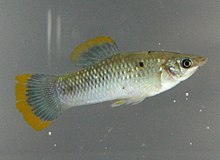This is an old revision of this page, as edited by Micromesistius (talk | contribs) at 09:42, 5 November 2024 (fix refs, size per FishBase, common names per FishBase). The present address (URL) is a permanent link to this revision, which may differ significantly from the current revision.
Revision as of 09:42, 5 November 2024 by Micromesistius (talk | contribs) (fix refs, size per FishBase, common names per FishBase)(diff) ← Previous revision | Latest revision (diff) | Newer revision → (diff) Species of livebearer fish
| Molly | |
|---|---|

| |
| Male molly | |
| Conservation status | |
 Least Concern (IUCN 3.1) | |
| Scientific classification | |
| Domain: | Eukaryota |
| Kingdom: | Animalia |
| Phylum: | Chordata |
| Class: | Actinopterygii |
| Order: | Cyprinodontiformes |
| Family: | Poeciliidae |
| Genus: | Poecilia |
| Species: | P. sphenops |
| Binomial name | |
| Poecilia sphenops (Valenciennes, 1846) | |
| Synonyms | |
| |
Poecilia sphenops, called the molly or Mexican molly, is a poeciliid fish inhabiting freshwater streams and coastal brackish waters from Mexico to El Salvador and Honduras to Colombia. The wild-type fishes are dull, silvery in color. The molly can produce fertile hybrids with many Poecilia species, most importantly the sailfin molly. The male mollies generally tend to be mildly aggressive. Females of the species prefer an external temperature of 29°C year round, whereas males prefer an external temperature of 29.6°C in the winter, and 25.5°C in the summer. This species of fish is seen to have a minimum lethal external temperature of 10.8–11.8°C, and a maximum lethal external temperature of 38.8–39.5°C when acclimated in a range of 20–35°C.
Poecilia sphenops can grow to 7.5 cm (3.0 in) standard length.
Gallery
References
- ^ Matamoros, W.A. (2019). "Poecilia sphenops". IUCN Red List of Threatened Species. 2019: e.T191753A2002434. doi:10.2305/IUCN.UK.2019-2.RLTS.T191753A2002434.en. Retrieved 19 November 2021.
- ^ Froese, Rainer; Pauly, Daniel (eds.). "Poecilia sphenops". FishBase. June 2024 version.
- Hernández, M; Bückle, L F; Espina, S (2002–2010). "Temperature preference and acclimation in Poecilia sphenops (Pisces, Poeciliidae)". Aquaculture Research. 33 (12): 933–940. doi:10.1046/j.1365-2109.2002.00744.x.
- Hernández-Rodríguez, Mónica; Bückle-Ramirez, L. Fernando (2010). "Preference, tolerance and resistance responses of Poecilia sphenops Valenciennes, 1846 (Pisces: Poeciliidae) to thermal fluctuations". Latin American Journal of Aquatic Research. 38 (3): 427–437. doi:10.3856/vol38-issue3-fulltext-7. ISSN 0718-560X.
Further reading
- "Mollies Fish" Detailed information on raising the Molly fish. January 2022 version
| Taxon identifiers | |
|---|---|
| Poecilia sphenops | |
This Cyprinodontiformes article is a stub. You can help Misplaced Pages by expanding it. |


